Auto Insurance Coverage Limits
Determine the maximum payout by insurers for auto accident claims.
Your Limits

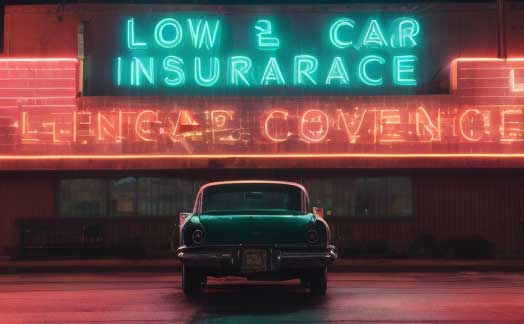
When purchasing auto insurance, one of the most important decisions you’ll make is choosing your coverage limits. Your limits determine how much money your insurance company will pay if you’re in an accident. Choosing limits that are too low could leave you financially vulnerable, while limits that are too high result in paying higher premiums. Follow this guide on how to select appropriate coverage limits for your needs and budget.
What are Coverage Limits?
Your auto insurance policy has three main coverages – bodily injury liability, property damage liability, and physical damage. Each coverage has its own limits that cap the amount your insurer will pay per accident.
- Bodily injury liability covers injuries to others caused by your vehicle. Limits are commonly shown as 50/100/50, meaning $50,000 per injured person, $100,000 total per accident, and $50,000 total for property damage per accident.
- Property damage liability covers damage your car does to others’ property. Limits are usually around $50,000 total per accident.
- Physical damage covers repairs to your own vehicle from collisions, theft, vandalism, weather, floods, and more. Limits equal the actual cash value or replacement cost of your car.
State Minimum Coverage Requirements
Every state requires drivers to carry a minimum amount of liability insurance. If you cause an accident, your insurer will pay up to the state minimums for injuries and damages, but you would be personally responsible for any losses above that amount.
Minimums vary significantly by state from as low as $10,000 per person/$20,000 per accident in Florida to $50,000/$100,000 in Alaska. Make sure you know your state’s requirements. Carrying only the minimums leaves you vulnerable to potentially bankrupting liability, so consider opting for higher limits.
Choosing Higher Limits
Though cost is a major factor, selecting auto insurance limits shouldn’t be based on price alone. Here are some guidelines for choosing appropriate limits:
- Income and Assets – If you have significant income and assets to protect, consider higher liability limits to guard your finances. Umbrella insurance can provide additional liability coverage above your auto policy limits.
- Type of Vehicle – If you drive an expensive luxury or sports car, higher physical damage coverages are wise to fully protect your vehicle in case it’s totaled.
- Driving History – Drivers with accidents/violations on record pose higher risk and may want increased liability limits in case they cause an accident.
- Frequency of Driving – Limits can be lower if you drive infrequently, but should be higher if you drive long distances regularly.
- Location – Urban areas with high rates of accidents and lawsuits may warrant higher bodily injury liability limits.
- Passengers – Higher per-person limits help sufficiently cover injuries to passengers if you frequently drive others.
- Health Insurance – Lower medical payment coverage is okay if you already have ample health insurance to cover accident injuries.
Liability Coverage Limits
Choosing the right liability limits for your car insurance is an important decision that requires careful consideration. Liability insurance covers damages and injuries you cause to others in an accident. Higher liability limits mean you have more coverage, but also typically come with higher premiums. Here are some tips for choosing appropriate liability limits:
- Know your state’s minimum requirements. Most states require drivers to carry a minimum of 25/50/10 liability coverage, which stands for $25,000 bodily injury per person, $50,000 bodily injury per accident, and $10,000 property damage. Consider going above these minimums for better protection.
- Assess your assets and net worth. If you have significant assets that could be at risk in the event of a lawsuit after an at-fault accident, choose higher limits like 100/300/100 to provide more coverage. If you have few assets, lower limits may suffice.
- Factor in potential medical costs. Medical bills from even minor accidents can easily exceed $25,000. Higher liability limits ensure you can cover major medical expenses for other parties. Bodily injury limits of $100,000/$300,000 or more are recommended.
- Consider your driving habits. If you drive frequently, have a long commute, or transport children/passengers often, opt for higher liability limits to hedge against potential increased accident risk. More coverage also makes sense if you own a luxury vehicle.
- Get quotes for different limits. Increasing liability limits will increase your premiums, so get quotes across coverage levels. Go with the highest limits you can afford. 100/300/100 or 250/500/100 offers robust coverage for many drivers.
- Review limits regularly. As your assets and net worth grow over time, consider increasing liability limits at renewal to provide stronger financial protection.
Collision Coverage Limits
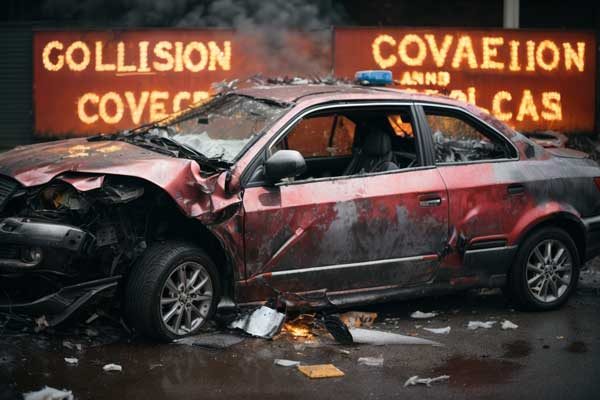
Choosing the right collision insurance limits for your auto policy is an important decision that requires some thought. Collision coverage pays to repair or replace your vehicle if it’s damaged in an accident, regardless of who is at fault. Your collision limits determine how much your insurer will pay.
Set limits that are too low and you could end up paying thousands out of pocket for repairs or replacement. But set limits too high and you’ll pay higher premiums than necessary. Follow this guide to help determine suitable collision limits for your situation.
Understanding Collision Insurance
Collision coverage is optional for auto policies in most states. It covers damage to your vehicle from an accident with another car or object, like a telephone pole or guardrail.
Collision does NOT cover damage from hitting an animal, flood, fire, theft, vandalism, or wind. Those perils are covered under comprehensive or other policy add-ons.
The two main parts of collision coverage are:
- Your deductible: This is the amount you pay out-of-pocket toward a covered repair before insurance kicks in. Common deductibles are $250, $500, and $1,000. The higher your deductible, the lower your premium.
Without collision coverage, you’d have to pay that full $6,000 repair bill yourself.
- Your limits: This is the maximum dollar amount your insurer will pay for a covered loss. Limits typically match the actual cash value (ACV) of your vehicle.
For example, let’s say you have a $500 deductible and $5,000 collision limit. If you have an accident that causes $6,000 in damage, you would pay the $500 deductible. Your insurer would then cover the remaining $5,000 repair bill.

Factors You Should Take Into Consider When Deciding On Limits
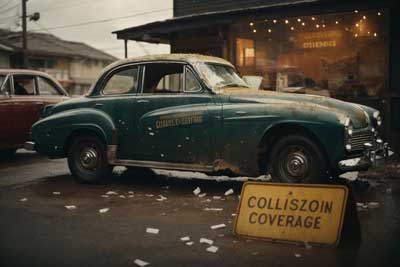
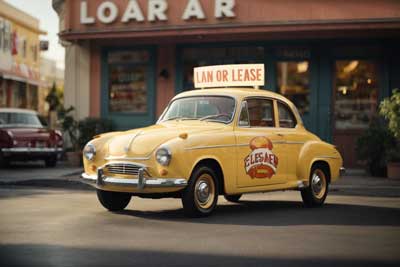

When choosing collision limits, here are some important things to consider:
- Value of your vehicle: Your limits should be equal to the ACV or replacement value of your car, truck or SUV. Accurately valuing your vehicle is key to getting appropriate coverage.
- Cost to repair or replace: How much would it cost to repair or replace your vehicle if it were totaled? Limits should be sufficient to cover those costs after deducting your deductible.
- Condition of your vehicle: For an older car with high miles or existing damage, a lower limit may be fine because the vehicle has depreciated. But for a newer vehicle, you’ll need higher limits closer to its current value.
- Loan or lease: If you have an auto loan or lease, your lender or lessor will require collision coverage with limits equal to the vehicle’s value. Review your loan documents to see the required limit amounts.
- Driving habits: Do you commute long distances? Drive in dense urban areas? If so, you may be at higher risk for an accident so higher limits are safer. But if you have a short commute and defensive driving skills, lower limits may suffice.
- Location: If you live in an area with high auto repair costs or a high cost of living, consider higher limits to cover those regional differences.
- Deductible amount: As mentioned, the lower your deductible, the higher your premiums. By choosing a higher deductible, you can reduce premium costs while still having ample coverage limits.
- Multi-vehicle policies: If you insure more than one vehicle on your policy, you may qualify for discounts that help offset the cost of higher collision limits.
- Claim history: If you’ve filed collision claims before, especially recently, keep your limits robust. Insurers may not renew policies if the policyholder makes frequent claims.
- Budget: Of course your budget plays a role. Balance premium costs against the level of protection higher limits provide. Don’t skimp too much or you’ll risk paying thousands out-of-pocket for repairs.
Estimating Your Vehicle's Value
A key step in choosing collision limits is determining your vehicle’s actual cash value or replacement value. Here are some tips for estimating value:
- Check Kelley Blue Book (KBB.com): Enter your vehicle’s make, model, year, features, and condition to get its private party and trade-in values. Aim for a limit around the private party sale value.
- Get an appraisal: For a more accurate value on a classic or customized vehicle, hire an independent appraiser to assess its worth. This provides documentation for setting coverage limits.
- Review NADA Guides (NADAguides.com): Like KBB, this site lists values for used vehicles. Cross-check values against KBB for an accurate range.
- See dealer prices: Visit dealership websites to see listing prices for similar pre-owned vehicles. This can give you insight into current retail values.
- Check resale listings: Look at prices for vehicles like yours listed for sale online and in newspaper ads. Again this reveals private party asking prices.
- Talk to your agent: Discuss your vehicle and how much it would cost to replace it with your insurance agent. They can help pinpoint adequate limits.
Having an accurate value of your vehicle gives you a target number for collision limits. Next, let’s look at how deductible size interacts with limits.
Deductible vs. Limits
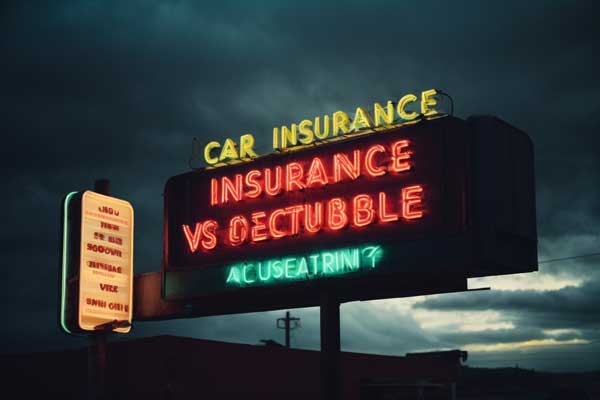
As mentioned, your deductible is the amount you pay out-of-pocket when a collision claim is filed and approved. Common deductible amounts are $250, $500, and $1,000, but you can choose other amounts.
Choosing a lower deductible means you have to pay less upfront for a covered repair. However, it also increases your premiums.
Conversely, choosing a higher deductible lowers your premiums but means you have to pay more upfront for repairs before insurance kicks in.
Experts recommend choosing the highest deductible amount you can reasonably afford to pay in cash if needed. This gives you premium savings while still providing ample coverage above the deductible amount.
Let’s look at some examples to see the interplay between deductibles and limits:

Example 1:
$500 deductible, $5,000 limit In this case, you'd pay the first $500 for a covered repair and your insurer would cover the next $4,500. Total coverage is $5,000 including your deductible.
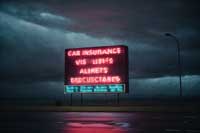
Example 2:
$1,000 deductible, $5,000 limit Here you pay $1,000 out of pocket and the insurer covers the next $4,000. Again $5,000 total coverage but you pay more upfront.

Example 3:
$250 deductible, $2,500 limit Here your out-of-pocket cost is only $250 but your total coverage tops out at $2,500. A higher claim amount leaves you responsible for the overage.
As you can see, choosing a higher deductible allows you to maintain ample coverage limits at a lower premium cost. Just be sure you have the cash on hand or access to credit to cover the deductible amount if needed.
How Much Car Insurance Coverage is Enough?

Choosing suitable coverage limits depends on your finances and risk tolerance. It also depends on the value of your vehicle.
Older cars with low values may only need state minimum limits, such as $5,000. However, for newer cars or luxury vehicles, experts recommend 100/300 liability coverage. For collision/comprehensive consider limits equal to the car’s value or financing amount.
Here are some general guidelines on collision coverage limit amounts to consider
$5000 limit
- For older vehicles with little value. Limit your risk exposure
Limits equal to vehicle value
- Provides peace of mind by covering potential total loss.
$10,000 Limit
- For vehicles up to 5 years old that are paid off. Limits injury risk.
$15,000+ limit
- For newer vehicles financed or leased. Meet lender/lessor requirements.
State minimum limits
Check what's required in your state. May be $5,000 or higher.
Again, choosing the right amount requires balancing premium costs versus your level of risk tolerance. Protect your assets while avoiding overspending on premiums.
Choosing the Right Limits Protects Your Assets
Collision insurance is an essential protection for your vehicle. Take the time to carefully evaluate your needs and pick suitable coverage limits and deductibles. An independent insurance agent can explain all aspects of collision coverage.
Getting collision limits aligned with your vehicle’s value keeps you safe from major out-of-pocket repair bills. At the same time, don’t overpay on premiums by choosing excessively high limits you don’t need. Finding the right balance takes some research and number crunching.
Use the guidance in this article to make an informed, financially smart decision about collision limits for your auto policy. That ensures you get solid coverage at an affordable rate. Drive with the peace of mind that comes from picking the right collision insurance plan.
Comprehensive Coverage Limits
Deciding on the right comprehensive insurance limits for your vehicle can be a challenging task. Comprehensive coverage pays to repair or replace your vehicle if it’s damaged by something other than a collision, like theft, vandalism, fire, flood, or hail. Higher limits mean you’ll pay less out-of-pocket if you need to file a claim. However, higher limits also mean paying higher premiums.
You’ll need to balance your desire for protection against potential costs. This article provides a comprehensive guide on how to select appropriate comprehensive coverage limits.
What Does Comprehensive Insurance Cover?
Comprehensive insurance covers your vehicle for perils other than collisions. This includes:
- Theft or vandalism – Your car is stolen or damaged by others. Comprehensive pays to repair or replace it.
- Weather events – Storms, floods, wind, hail, or falling objects like tree branches. Comprehensive covers damage from these types of events.
- Fire – If your vehicle catches fire from something like electrical issues or arson, comprehensive insurance will pay for repairs or replacement.
- Animals – Collisions with animals like deer or bears are covered by comprehensive.
- Glass damage – Rocks hitting your windshield, windows, or sunroof. Comprehensive insurance pays for glass repair or replacement.
So in short, comprehensive coverage is for “everything else” besides collision. This type of coverage is important to consider if you have a new or newer vehicle.
How Comprehensive Insurance Limits Work
Comprehensive insurance pays up to the limit you select if you have a covered loss. Limits are typically shown as a dollar amount, such as $5,000 or $10,000.
The limit functions as the maximum the insurance company will pay per loss. For example, say a large hailstorm causes $7,000 worth of damage to your car. If your comprehensive limit is $5,000, you’d have to pay the other $2,000 out-of-pocket.
With higher limits, you lower the chances of having to pay anything yourself if you have a major claim. But higher limits mean higher premiums, so you have to find the right balance.
What Factors Impact Your Comprehensive Coverage Limits?
Several variables determine what comprehensive insurance limits make sense for your situation:
- Value of your vehicle – The most significant factor. If your car is worth $15,000, a $1,000 comprehensive limit leaves you exposed.
- Type of vehicle – Sports cars and luxury vehicles are more tempting targets for thieves and vandals. Higher limits are wise.
- Location – If you live in an area prone to hail, floods, or extreme weather, higher limits can prevent large out-of-pocket costs.
- Deductible amount – Some insurers allow you to select a separate deductible for comprehensive claims, usually $100 to $500. The higher your deductible, the lower your premiums but the more you pay per claim. Factor your deductible into your limits decision.
- Budget – Ultimately premium costs factor into what limits you can afford. Balance premium costs against your level of risk tolerance.
With these factors in mind, what are some guidelines on comprehensive coverage limits?
Recommended Limits Based on a Vehicles Value
A general rule of thumb is to purchase limits equal to the actual cash value (ACV) of your vehicle. ACV is what the insurance company would pay if the vehicle was totaled, factoring in depreciation.
Here are some recommendations on comprehensive limits based on your car’s current value:
- Up to $5,000 car value – Minimum of $5,000 in limits. This ensures the entire value is covered.
- $5,000 to $10,000 value – $10,000 is a good target limit amount.
- $10,000 to $15,000 value – Limits of $15,000 to $20,000 are appropriate.
- $15,000 to $25,000 value – Consider limits of $25,000 or higher.
- Over $25,000 value – Limits equal to the full value of the vehicle are wise.
The goal is to select limits high enough that you’d never have an out-of-pocket expense if the vehicle was totaled by something like theft or hail damage.
When Higher Limits Make Sense
In some cases, it can make sense to purchase comprehensive limits above your vehicle’s current value:
- New and newer vehicles – Cars tend to depreciate quickly in the first few years. Buying higher limits provides a buffer as the value declines. Revisit limits when renewing your policy.
- Leased vehicles – The lease contract may require you to maintain coverage equal to the vehicle’s original value. Review lease terms to ensure you meet requirements.
- Area with frequent weather losses – If you live where wind, hail or floods are common, higher limits can prevent paying thousands out-of-pocket for repairs.
- High-theft vehicles – Limits that exceed the value by $2,000 or more give you a cushion in case the entire car is stolen.
- Low deductibles – If you select a $100 comprehensive deductible, having higher limits prevents the deductible from eating significantly into a settlement.
- Peace of mind – For some added peace of mind, slightly higher limits may be preferred even if the value is covered.
In these situations, purchasing limits 5-20% above your car’s ACV can be reasonable.
Lower Limits to Reduce Premiums
On the other hand, you may decide lower comprehensive limits are sufficient
- Older vehicles – Once a vehicle is 10+ years old with over 100k miles, collision coverage is often dropped. Lower comprehensive limits of $2,000 or $3,000 may suffice to cover a total loss.
- Part-time vehicles – For a secondary vehicle not driven regularly, lower limits of just a few thousand dollars are likely adequate.
- Tight budget – If you’re looking to reduce insurance costs, dropping comprehensive limits to $3,000 to $5,000 is an option. Just be prepared to pay out-of-pocket for losses exceeding the limits.
The downside of course is being severely underinsured in the event of a major loss. But for budget-conscious consumers with older vehicles, lower limits may be a reasonable compromise.
How to Determine the Right Limits
Here’s a process to determine appropriate comprehensive coverage limits for your situation:
- Check your current vehicle value – Use an online car value estimator like Kelley Blue Book and determine your car’s current private party and trade-in values. Go with the higher number as that’s what the insurer would use to total it out.
- Consider your risk factors – Do you live in an area prone to weather losses? Is your car especially theft-prone? Are you leasing? These raise the case for higher limits.
- Determine your budget – Factor in the premium costs of different limit options, balancing this against your level of risk tolerance.
- Select target limits – Using the value, risk factors, and budget considerations, select your minimum needed limits, then bump them up slightly for an extra cushion if affordable.
- Review regularly – Re-evaluate your limits at each policy renewal as your car depreciates and risk factors evolve.
Purchasing the Right Amount of Coverage
Choosing suitable comprehensive insurance limits requires balancing your vehicle’s value, risk factors, deductible, and budget. Follow the tips in this guide as a starting point, but make adjustments depending on your specific situation.
The key is making sure you have enough coverage that you’d never have any out-of-pocket costs in the event of a total loss. But don’t overbuy limits that give minimal additional protection while adding significantly to your premiums.
Carefully considering how much comprehensive coverage you need, along with all your other coverages, ensures your vehicle is properly protected from all loss scenarios. Reviewing your comprehensive limits annually helps maintain the right level of protection as your vehicle ages.
The Right Limits Provide Peace of Mind
Selecting the proper auto insurance limits involves balancing your finances, risk tolerance, and need for protection. While state minimums get you legal coverage, they may not be enough. Analyze your specific situation, compare quotes, and apply tips to find cheaper rates on higher, adequate limits. With the right coverages and limits in place, you’ll have peace of mind knowing you’re well-protected on the road.
To compare rates where you live, fill out an online application. Review up to ten quotes in five minutes. Get the auto insurance coverage and limits you need for less.

Author: David Haan
David Haan is a professional writer who has a passion for writing about financial topics: including investing, insurance, and entrepreneurship. David has a way of simplifying complex financial topics to make it easy for anyone to understand. During his free time, he likes to play volleyball, surf, and listen to jazz music.

Pingback: Cheap Used Car Insurance – insurance coverage